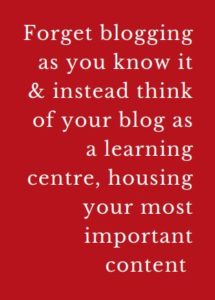Most business blogs are terrible.
They’re used for things like announcements and fluffy content that does nothing to capture leads and
make sales. And if all you want is a place to jot down your thoughts, then skip this article.
But if you want a blog that gets you more leads and more sales with every single piece of content you write, then read on.
Forget about blogging as you know it and instead think of your blog as a learning centre. This learning centre will be a hub for all of your website’s most important content. Visitors will be able to find answers to their problems and find information on what they want to know.
You’re going to create content that resonates with your target audience and influences them to make a buying decision. Your goal should be to educate your prospects into becoming customers, and your customers into making repeat sales.
And you’re going to do this without advertisements for your offerings. The problem with ads is they are
biased and present only one solution to a customer’s problem. This makes prospects skeptical and loses you the sale.
But when you fill your blog with the honest help your prospects are looking for, then you move from being a sales person to becoming a trusted authority. And that gets you readers, subscribers and sales.

Your website should be your best salesperson, working for you 24/7 to make sales.
I remember years ago when I needed to buy kitchen appliances. I went to a local store and got lucky enough to be waited on by a man who had been in the appliance business all of his life. He didn’t own the store, he just sold appliances, and he knew everything there was to know about every model there on the floor as well as models sold in other stores. He told me point blank which models to avoid and what sort of problems they had. He steered me away from an overpriced model with good reviews because the nearest service person for that model was two hours away, and if it broke, getting it fixed would be a nightmare. He told me what was available at the other stores and how much they were on sale for that day. He knew the factories where each were built, their overall reputations and which brands and models needed the most service calls over their lifetimes. Keep in mind, this was in the mid 90’s before the reliable online reviews were prevalent. It was the only time in my whole life that I truly trusted the sales person. He wasn’t trying to sell me anything; he was trying to educate me on what would be best for my needs.
I wound up buying three appliances from him and one that he highly recommended from his competitor. And I was so pleased, over the next few years I sent him enough business to sell another 2 dozen appliances.
Now imagine your website could be like that sales person. Your content is educational and easy to access, just like asking that sales person questions.
A visitor comes to your site via organic search and lands on an article giving general information about your niche. Let’s use roof repair and replacement as an example. They search for, “Do I need to replace my roof?” and land on your article, “How to know if you need a new roof.” Inside the article you have links to any terms they might not understand, so they can get immediate clarity. You talk about the reasons a roof might need to be repaired, with a link to another article covering each reason indepth. You also offer information on how to know if replacement is a better option, the different types of roofs available, a cost calculator and so forth. Everything they need to know about roof repair and replacement is right there. And woven throughout your content you give anecdotes of roofs you’ve repaired and replaced.

Here’s what’s happening on the visitor’s end: They’re finding the information they’re looking for, and they find it easily on their own and at their own pace.
This content isn’t selling them, it’s instructing them, which goes a long way to creating trust in your company.
Every piece of content offers multiple paths forward, including more specific content and a call to action so they can reach out to you when they are ready. Imagine someone spends thirty minutes or an hour on your website. When they’re ready to call an expert, whether it’s right then or in a month, who are they going to call? You.
The key to making this work is to find out what customers are asking, and then answering those questions for them while organising the content in a way that feels natural and intuitive. You are educating your user through the buyer’s journey.
Homeowners seldom begin with, “I need a new roof.” Instead, they start out on the journey wondering IF they need a new roof, if they can get the current roof repaired, how do they know if there is a problem, who can they trust, how much will it cost, what type of roof should they get… It’s complicated.
Read our full February Newsletter here


